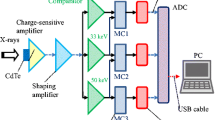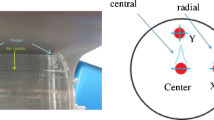Abstract
An energy-discrimination K-edge X-ray computed tomography (CT) system is useful for increasing the contrast resolution of a target region by utilizing contrast media. The CT system has a cadmium telluride (CdTe) detector, and a projection curve is obtained by linear scanning with use of the CdTe detector in conjunction with an X-stage. An object is rotated by a rotation step angle with use of a turntable between the linear scans. Thus, CT is carried out by repetition of the linear scanning and the rotation of an object. Penetrating X-ray photons from the object are detected by the CdTe detector, and event signals of X-ray photons are produced with use of charge-sensitive and shaping amplifiers. Both the photon energy and the energy width are selected by use of a multi-channel analyzer, and the number of photons is counted by a counter card. For performing energy discrimination, a low-dose-rate X-ray generator for photon counting was developed; the maximum tube voltage and the minimum tube current were 110 kV and 1.0 μA, respectively. In energy-discrimination CT, the tube voltage and the current were 60 kV and 20.0 μA, respectively, and the X-ray intensity was 0.735 μGy/s at 1.0 m from the source and with a tube voltage of 60 kV. Demonstration of enhanced iodine K-edge X-ray CT was carried out by selection of photons with energies just beyond the iodine K-edge energy of 33.2 keV.














Similar content being viewed by others
References
Sato E, Sagae M, Tanaka E, Hayasi Y, Germer R, Mori H, et al. Quasi-monochromatic flash X-ray generator utilizing a disk-cathode molybdenum tube. Jpn J Appl Phys. 2004;43:7324–8.
Sato E, Tanaka E, Mori H, Kawai T, Inoue T, Ogawa A, et al. Characteristic X-ray generator utilizing angle dependence of bremsstrahlung X-ray distribution. Jpn J Appl Phys. 2006;45:2845–9.
Germer R. X-ray flash techniques. J Phys E Sci Instrum. 1979;12:336–50.
Shikoda A, Sato E, Sagae M, Oizumi T, Tamakawa Y, Yanagisawa T. Repetitive flash X-ray generator having a high-durability diode driven by a two-cable-type line pulser. Rev Sci Instrum. 1994;65:850–6.
Takahashi K, Sato E, Sagae M, Oizumi T, Tamakawa Y, Yanagisawa T. Fundamental study on a long-duration flash x-ray generator with a surface-discharge triode. Jpn J Appl Phys. 1994;33:4146–51.
Sato E, Tanaka E, Mori H, Kawai T, Sato S, Takayama K. Clean monochromatic X-ray irradiation from weakly ionized linear copper plasma. Opt Eng. 2005;44:049002-1–6.
Sato E, Hayasi Y, Germer R, Tanaka E, Mori H, Kawai T, et al. X-ray spectra from weakly ionized linear copper plasma. Jpn J Appl Phys. 2006;45:5301–6.
Sato E, Obara H, Enomoto T, Tanaka E, Mori H, Kawai T, et al. X-ray spectra from a brass-target plasma triode. Jpn J Med Phys. 2008;27:163–71.
Sato E, Hayasi Y, Kimura K, Tanaka E, Mori H, Kawai, et al. Enhanced K-edge angiography utilizing tantalum plasma X-ray generator in conjunction with gadolium-based contrast media. Jpn J Appl Phys 2005;44:8716–21.
Sato E, Hayasi Y, Tanaka E, Mori H, Kawai T, Inoue T, et al. K-edge angiography utilizing a tungsten plasma X-ray generator in conjunction with gadolinium-based contrast media. Rad Phys Chem. 2006;75:1841–9.
Thompson AC, Zeman HD, Brown GS, Morrison J, Reiser P, Padmanabahn V, et al. First operation of the medical research facility at the NSLS for coronary angiography. Rev Sci Instrum. 1992;63:625–8.
Mori H, Hyodo K, Tanaka E, Mohammed MU, Yamakawa A, Shinozaki Y, et al. Small-vessel radiography in situ with monochromatic synchrotoron radiation. Radiology. 1996;201:173–7.
Hyodo K, Ando M, Oku Y, Yamamoto S, Takeda T, Itai Y, et al. Development of a two-dimensional imaging system for clinical applications of intravenous coronary angiography using intense synchrotron radiation produced by a multipole wiggler. J Synchrotron Radiat. 1998;5:1123–6.
Sato E, Tanaka E, Mori H, Kawai T, Ichimaru T, Sato S, et al. Demonstration of enhanced K-edge angiography using a cerium target x-ray generator. Med Phys. 2004;31:3017–21.
Sato E, Tanaka E, Mori H, Kawai T, Inoue T, Ogawa A, et al. Variations in cerium X-ray spectra and enhanced K-edge angiography. Jpn J Appl Phys. 2005;44:8204–9.
Matsukiyo H, Watanabe M, Sato E, Osawa A, Enomoto T, Nagao J, et al. X-ray fluorescence camera for imaging of iodine media in vivo. Radiol Phys Technol. 2009;2:46–53.
Sato E, Purkhet A, Matsukiyo H, Osawa A, Enomoto T, Watanabe M, et al. Energy discriminating X-ray camera utilizing a cadmium telluride detector. Opt Eng 2010; 48 (in press).
Nakashima T, Mori H, Neo Y, Mimura H, Aoki T. Application of CdTe photon-counting X-ray imager to material discriminated X-ray CT. Proc SPIE. 2007;6706:67060C-1–9.
Hernandez RJ, Strouse PJ, Londy FJ, Wakefield TW. Gadolinium-enhanced MR angiography (Gd-MRA) of thoracic vasculature in an animal model using double-dose gadolinium and quiet breathing. Pediatr Radiol. 2001;31:589–93.
Acknowledgments
This work was supported by Grants-in-Aid for Scientific Research and Advanced Medical Scientific Research from MECSST, Health and Labor Sciences research grants, grants from the Keiryo Research Foundation, The Promotion and Mutual Aid Corporation for Private Schools of Japan, the Japan Science and Technology Agency, and the New Energy and Industrial Technology Development Organization.
Author information
Authors and Affiliations
Corresponding author
About this article
Cite this article
Abudurexiti, A., Kameda, M., Sato, E. et al. Demonstration of iodine K-edge imaging by use of an energy-discrimination X-ray computed tomography system with a cadmium telluride detector. Radiol Phys Technol 3, 127–135 (2010). https://doi.org/10.1007/s12194-010-0088-8
Received:
Revised:
Accepted:
Published:
Issue Date:
DOI: https://doi.org/10.1007/s12194-010-0088-8




